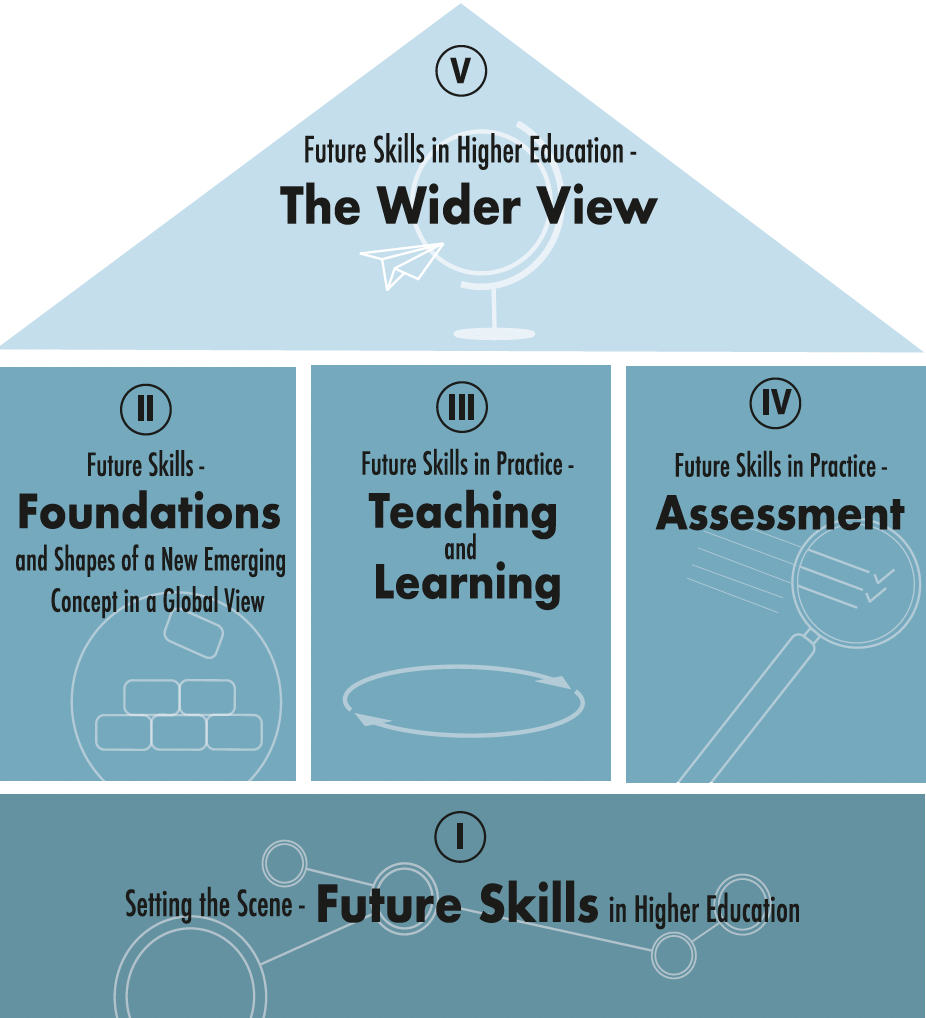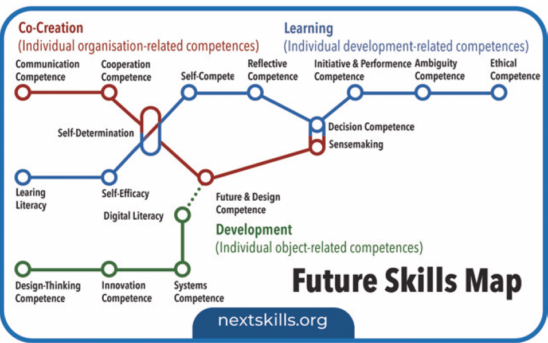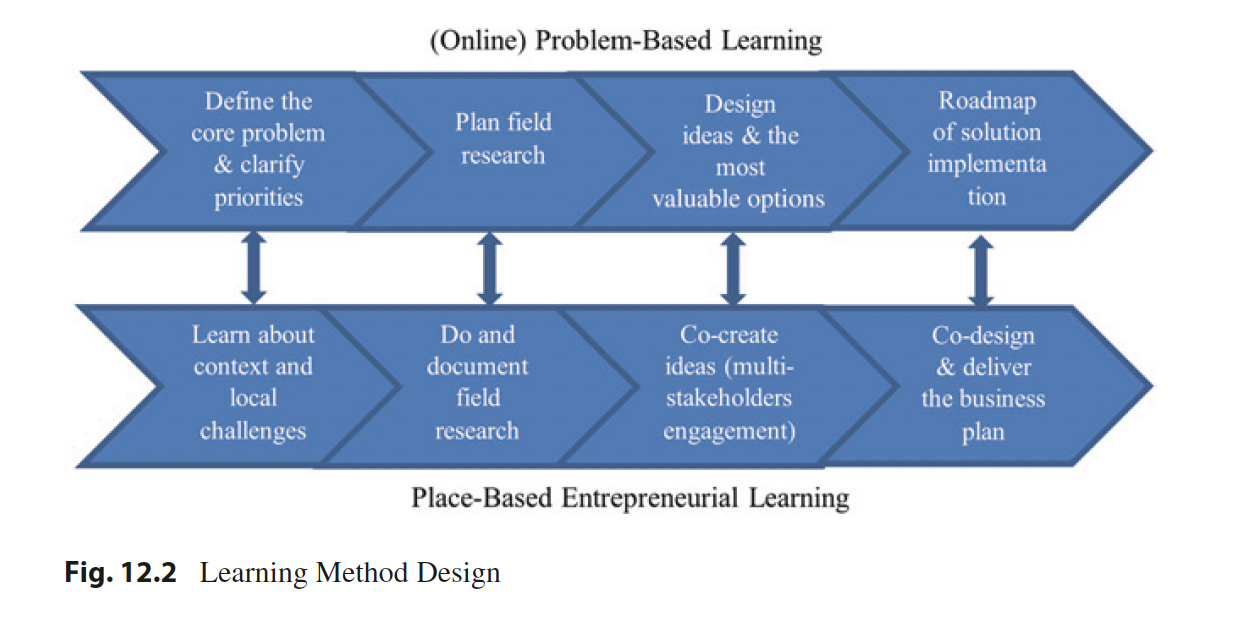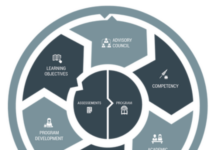
Ehlers, U-D. and Eigbrecht, L. (eds) Creating the University of the Future A Global View on Future Skills and Future Higher Education Springer VS https://doi.org/10.1007/978-3-658-42948-5 pp. 637
This is an open access book in pdf.
This a very long review, but this is such an important book on the future of higher education that it deserves extensive coverage.
What is this book about?
The editors in their preface state:
The world is changing at a pace never before seen in history. Rapid advancements in technology, globalization, and shifting demographics are reshaping the world we live in. The skills that were once considered essential for success are becoming obsolete, and new skills are emerging in their place. In this book, we explore the Future Skills that will be essential for individuals to thrive in the future, and how universities can adapt to equip students with the skills they need to succeed.
What started as a book focused on skills has then morphed into what the editors call a new vision for the future university.
What is in the book?
This book presents visionary higher and tertiary education programs aiming at Future Skills for their graduates. It compiles contributions from more than 50 authors who are engaged in global intergovernmental organizations such as UNESCO and OECD involved in research and policy-making as well as from higher and tertiary education institutions from different countries and continents.
This volume aims at increasing visibility for existing and emerging innovative teaching and learning practices for educational professionals, while informing educational leaders about the newest Future Skills strategies, and inspiring all educational stakeholders on their journey towards future-ready higher education.
Summarising a book of 600+ pages for a blog is a challenge, but this book proved worth the effort. Altogether there are 30 chapters. Unlike many collection of papers, though, these chapters have a coherence driven by a focus on the development of future skills, in different contexts and from different aspects. My actual views on the book will be found at the end.
Part 1: What is meant by ‘Future Skills’?
Part I focuses on introducing the concept and relevance of Future Skills and giving an overview to the reader by introducing the different contributions.
The editors state (p.4):
Higher education institutions must address the question: which Future Skills will the graduates of tomorrow need, and how can they support them in acquiring them?…..Future Skills are skills which enable students to collectively impact societal transformation in order to create more sustainable futures. In other words, we define Future Skills as competences that enable individuals to solve complex problems in a self-organized manner and to act (successfully) in highly emergent contexts. They are based on cognitive, motivational, volitional, and social resources, are value-based, and can be acquired in a learning process.

For example, if the task is to develop a solution to a new problem, often the ability to approach the problem from different perspectives, the flexibility and openness to accept several pathways to a solution, and interdisciplinarity are important
We decided to introduce labels for these competence areas and combine several competences into one “Future Skill” profile—in this case with the label “design-thinking competence” (Ehlers, 2020). If, for example, another area involves dealing with increasingly networked, often multiple, unclear, and complex organizational roles and contexts at work,….skills such as dealing with ambiguity, acting in uncertain situations, and dealing with heterogeneity are important. These skills are also combined into one label in the NextSkills study, called “ambiguity competence”.
“Future Skills” are therefore about those competencies that are of particular importance for the ability to act in such future situations, which, due to their rapid changes, repeatedly produce new, complex problem situations, for which preparation through education and training in a traditional sense (knowledge transfer in a preparational mode) is no longer effective.
In his introductory chapter (pp.21-57), Ehlers further elaborates on the definition of future skills and the contexts needed to support such skills development. In all, Ehlers suggests 17 Future Skills ‘profiles’ or ‘competences’, such as self-determination, responsibility-taking, dealing with uncertainty, etc., based on both theory and research.
In an interview for the book (pp.75-92) Schleicher states: Future Skills are not about a specific skill set that we can define today and that will be valid forever—they are about our capacity to be open to alternative futures, to be receptive to how the evolution of labor demand, of skill demand really evolves and then to find creative responses to this.
Part II: Foundations
Part II focuses on discussing basic Future Skills concepts and approaches in (global) higher education.
Francesc Pedro of UNESCO in his chapter on educational innovation states (p.94): the examination of the evolution of teaching strategies over the past two decades shows that lecturing has remained the top method…..From the beginning of the nineteenth century, educational innovations have been constant, almost overwhelming at times, yet despite this, formal higher education continues to resemble itself globally because the underlying model is universal….the more things have changed on the surface of higher education institutions, the stronger the classic universal model has become.
Pedro defines educational innovation as a dynamic change that adds value to the processes occurring in a higher education institution (both pedagogical and organizational) and that results in improved student learning outcomes or educational stakeholder satisfaction, or both.
Tony Bates My own chapter in the book (pp.123-137) focuses on the need to incorporate future skills within the curriculum and on what we know about how to teach skills, how best to integrate skills teaching within the curriculum, and how to assess the skills we want our students to develop in a way that builds from course to course and ultimately over a lifetime.
Wolfgang Stark , Germany, discusses community service-learning, linking civil society, universities and business, as one route to skills development (pp.139-159).
In an interview with the editors (pp.160-173), Tom Wabeke states that [Defining and implementing future skills] should not be only the discussion of educational specialists and stakeholders. It should become a societal type of discussion with a co-creation approach… what is the world we want? Having an entire population or at least an important part of that population think about the same question—that would be the greatest way to think about the future of education
Chacon et al. (pp. 175-198) discuss a ‘new theory of change’ that supports efforts to identify the skills needed by future generations that higher education can provide. They draw on a public consultation by UNESCO, where almost 1,200 responses from nearly 100 countries were collected through an online survey tool. Respondents envisioned higher education in 2050 as being much more integrated than today and connected at multiple levels with society, with the planet, within and across borders.
Part III: Teaching skills
Part III provides a look at higher education practices in teaching and learning ‘Future Skills’ in different countries and institutions.
There is an interesting interview with the famous podcaster, Angela Duckworth (pp.202-214). She argues for the development in learners of curiosity, independence and connection, and character development and grit. In response to those policymakers who are worried that this is going to crowd out traditional subjects, she replies that these are complementary. Young people cannot succeed academically without these strengths of character. And when you have both, you’re enormously more effective, not only as a student, but as a person.
Michael Vogel (pp.215-240) argues that Future Skills are acquired best not through teaching, but learners’ self-directed action and reflection in authentic contexts. He discusses Team Academy where learners work as a team on ‘entrepreneurial’ projects with faculty as a coach. Future Skills cannot be taught in any traditional sense but require action and reflection by students in authentic contexts.
Carmen Păunescu and Mary McDonnell-Naughton (pp.241-260) argue that a hybrid system that combines online Problem-Based Learning (PBL) and onsite Place-Based Entrepreneurial Learning (PBEL) can be considered a viable setting for developing Future Skills when utilized within the specific context of entrepreneurship education, combining place-based community engagement, blended learning, and the use of Design Thinking tools

Michael Wihlenda (pp.261-282) discusses the approach of the World Citizen School, Tubingen. This is an alternative business school with an emphasis on self-organised social learning in teams
Sandhya Gunness, Karen Ferreira-Meyers and Thanasis Daradoumis, from Mauritius and Eswatini (formerly Swaziland) describe (pp.283-311) an attempt to equip recently graduated young citizens with a set of transdisciplinary skills and competencies along with the depth of academic knowledge gained at the university Their research focuses on how developing-state universities can breed more innovative and resilient workforces for a thriving and balanced work-life. There is need to give more importance in the curriculum to digital literacies, green skills, and ethical relationships within the world of work and higher education. Lack of time, lack of appropriate training, lack of departmental/institutional support towards online tools and technology, as well as inability to identify Future Skills’ needs in the job market, were all challenges
Felix Suessenbach, Judith Koeritz, Andreas Wormland and Henning Koch describe (pp.313-334) the German Stifterverband NGO, connecting stakeholders in a wholistic approach at the intersection of education, science, and innovation with a focus on entrepreneurial education and data literacy. They report on a Future Skills for Openness framework based on the question, “which competencies do academics in science and business need to be able to operate successfully in a working world, characterized by open science and open innovation?”. The initiative involved 39 projects, at a cost of 300,000 euros, across a diverse range of subject disciplines. Their report identified 11 obstacles/supporting factors.
Max Senges in an interview (pp.335-349) reports on 42 software engineering (coding) schools worldwide that offer ‘humanistic and tech’ education for 1800 students, covering IT and coding literacy, ‘planetary thinking’ and life entrepreneurship using gamification. There are no teachers, schedules or books. ‘If you are stuck with a problem, ask Google. If you are still stuck, ask a fellow student.’ At the end of each project, students submit the result of their work: functioning code. These schools are ‘playful, self-organized, cooperative learning spaces where studying happens in a community and also in self-selected teams, virtually or face-to-face’.
Mônica Cristina Garbin and Edison Trombeta de Oliveira of the Virtual University of Sao Paulo Brazil Interdisciplinary Program (IP) describe (pp.350-367) a teacher training program based on Human Centred Design and PBL. They suggest nine ‘premises’ for teaching twenty-first Century Skills. Students work in teams, problem-solving, via collaborative learning networks – all online. Hear, create, implement. The program was created to provide students contact with the professional world, in this case, schools and classrooms to break the dichotomy between theory and practice.
Juvy Lizette M. Gervacio Open University of Philippines Master of Public Management, describes (pp.373-392) a project with 50 students using online team work. The group tasks entailed online collaboration in analyzing public administration issues in the Philippines within the context of national development. It included self-assessment of future skills with peer assessment and instructor feedback.
André Luiz Maciel Santana and Roseli de Deus Lopes (pp.393-417) analyse and compile the results of an engineering program with 49 Brzilian students to operationalize real-world problem solutions in higher education by a User-Centered Design that aims to approach Future Skills in a Computer Engineering Course, using Design Thinking, teams, digital literacy, and problem-solving based on real-world problems. Groups of 3-6 students. worked with end users of the software (shoppers, electricity users, Altheimer’s patients). Global Future Skills are encouraged in this program when students start: (i) defining a real problem; (ii) improving the problem statement when interacting with real users; (iii) working within multidisciplinary teams; (iv) negotiating features and prioritizing tasks; (v) interacting with potential users; (vi) validating ideas or improving features; and (vii) when students work in an MVP approach, to evaluate how the solution could affect users’ problems, by giving more value, and less risk.
Part IV: Assessment
Part IV focuses on the important and hotly debated theme of assessment of Future Skills in higher education.
Nicole Geier and Ulf-Daniel Ehlers highlight (pp.421- 436) the existing attempts to use e-portfolios and student self-assessment to assess future skills. Self-assessment is characterised by the involvement of students in the process of defining standards and criteria against which they can later judge their achievements, following three steps: (1) The steps of the process should be clearly defined, (2) students must be well versed in self-assessment literacy, and (3) they must receive feedback from peers or teachers, respectively, and have the opportunity to discuss the results with others.
Megan K. Gahl, Abha Ahuja, Raquel H. Ribeiro, Maia Averett and James Genone describe (pp.437-456) the Minerva project and university, USA, that designs and delivers comprehensive interdisciplinary educational programs focused on teaching critical skills for academic and professional success. The focus is on four competencies: thinking critically, thinking creatively, communicating effectively, and interacting effectively. The pedagogical approach is fully active learning, so that students are engaged at least 75 percent of the time while in class and therefore collaborate in their own learning. Students prepare using asynchronous learning materials before class and then in-class time is spent engaging in higher-order cognitive tasks such as problem solving, peer instruction, and analysis. The assessments are scaffolded, from contributions in classroom discussions to open-ended, inquiry-based projects and assignments. Instructors are trained to assign rubric scores and provide qualitative assessments to provide students targeted, actionable feedback on specific LOs. In addition, students’ ability to transfer that skill or concept to other content areas through assessment of those same LOs across courses is evaluated. The program uses Forum, a unique class organising software.
Grame Barty, Naomi Boyer, Alexandros Chrysikos, Margo Griffith, Kevin House, Tara Laughlin, Ebba Ossiannilsson, Rupert Ward and Holly Zanville discuss (pp.457-487) badges, micro-credentials, and alternative credentials for assessing future skills. They present two current high school models, Green School and International School of Humanity, that each seek to build non-traditional learning experiences alongside recognition of longstanding and traditional knowledge and skills. Both models use the Mastery Transcript Consortium (MTC)3 online platform to build a competency-based credits system that captures durable, soft skills development as well as academic knowledge. The digital wallet becomes the repository for all learning and speaks to a learner’s future learning pathways and future work trajectory. Micro-credential wallets will reflect learners’ full skill sets.
Tobias Seidl discusses (pp. 488-506) formative assessment at the Faculty of Information and Communication at Stuttgart Media University. One aspect of the new model was the implementation of three mandatory 21st Century Skills modules (5 ECTS1 each) for all BA students. The modules focus on the development and improvement of metacognitive strategies (especially reflective skills) and the acquisition of important 21st Century Skills. About 450 students attend the modules each semester which are taught by one quarter of the departmental staff. Future skills such as KSAVE (Knowledge, Skills, Attitudes, Values and Ethics) can be easily transferred into learning objectives. The use of formative assessment formats increased students’ motivation to engage in new and uncertain courses of action and supported self-reflection processes. The module is passed (ungraded) if all three examination parts (compulsory, elective course, portfolio/colloquium) have been worked out to a sufficient degree. \When new content is added to the curriculum, existing content must be deleted.
Part V: The Wider View
Part V widens the perspective and presents selected national and international Future Skills initiatives and approaches.
Soon-Joo Gog, Edwin Tan and Kelsie Tan (pp.515-528). Singapore’s ‘The SkillsFuture Movement’ supports economic development through facilitating education, offering training options, and ensuring employer recognition. It is lead by the government’s Future Economy Council. The SkillsFuture Movement demonstrates that policy-led initiatives have brought about effective and wide-scale change in Singapore’s education system, and beyond. The Singapore Skills Framework clusters skills commonly required by job roles within each economy, and are determined via data science approaches supplemented by industry validation. In 2015 all Singapore citizens aged 25 and above received a training credit of S$500. Eligible employers received a one-off S$10,000 credit to cover up to 90% of out-of-pocket expenses, over and above existing programme subsidies. SkillsFuture Queen Bees (SFQBs) are industry leaders who take on a leading role to champion skills development in organisations. To support such a system, a citizen’s relationship with Institutes of Higher Learning lasts for a much longer time than if education were to be frontloaded before an individual formally embarks on their career. As such, Singapore is repositioning Institutes of Higher Learning (IHLs) as Institutes of Continuous Learning (ICLs). This is to signal that there is no limit to lifelong learning, and that there is no need to rush for the highest possible qualification before entering the workforce. As of 31 December 2021, 27% of eligible Singaporeans have used their SkillsFuture Credit; and 24,000 enterprises and 660,000 individuals participated in SkillsFuture-supported reskilling programs, an increase of 22% and 71% respectively from 2020. The Singapore experience suggests that a skills development agenda is integral to economic transformation and inclusive growth.
Miriam J. Green, Christalle Tay and Ye-Her Wu describe (pp.529-547) how the National University of Singapore contributes to strengthening Singapore’s workforce through its approach to Future Skills, as well as through collaboration with government and industry. They relate efforts to inculcate a culture of lifelong learning on the campus, and to provide opportunities for acquiring in-demand skills. To help protect future Singaporean workers from becoming redundant, NUS is taking a two-pronged approach: interdisciplinarity and lifelong learning, using stackable qualifications, especially at graduate level.
Marina Brunner and Ulf-Daniel Ehlers report (pp.569-587) on a survey conducted in 27 European member states and addressed to IT professionals and management staff in the IT sector. The studies reveal a gain in importance for Future Skills against other, more traditional, skill sets.
Stephen Marshall This chapter (pp.589-610) explores the New Zealand context. ‘Microlearning’ is a model proposed as an alternative for Future Skills development that avoids the pitfalls of credentialised approaches.
This is a very condensed overview and does not include all the chapters, but aims at indicating possible chapters of interest
My reaction to the book
This book is really a wake-up call to universities to change their fundamental approach to teaching and learning, away from knowledge transfer to ‘future’ skills development. It is also a wake-up call for governments, particularly those like Canada’s, where productivity has been static or declining for years. Universities and colleges should be essential for economic as well as personal development but they need a drastic change if they are to play that role, and this book offers hope on how this can be done.
As Schleicher says (p.83):
The university sector has remained the most conservative part of that ecosystem and I believe that in a way what makes the higher education sector so resistant to change is the success to bundle three things: owning the content, managing the delivery and basically being the accreditor—having the monopoly over deciding what a success in education is. It will take some time until higher education loses that monopoly.
This book provides important lessons on how that productivity could be improved. In particular the chapter on the way Singapore is preparing for the future is an eye-opener.
There are many chapters in this book that provide guidelines about why, and how, to develop and assess future skills, although I would say they tend to cluster in the areas of entrepreneurial/business studies and software programming, which are probably the most immediately obvious relevant areas. Also common teaching methods are problem-based learning, team learning, and the use of e-portfolios.
However, the book raises many questions, in particular not only which future skills should receive priority (which will probably depend to some extent on the ‘problem areas’ being addressed), but also whose responsibility it is for teaching some of these skills. For instance, although I agree completely with Angela Duckworth that grit and perseverance are essential qualities for success, whose responsibility is it to develop these qualities: the individual, parents, schools, or universities? Probably all of these but in different ways.
Another major issue this book raises for me is not just whose responsibility it is, but how we can change not only the faculty/teachers but also the institutions to enable such future skills to be developed and prioritised. This is such a big issue that I will do separate blog posts on the challenge of change for our instructors, institutions and governments resulting from the need to prioritise ‘future skills’, as well as respond to other major forces that require change in our institutions and our approach to teaching and learning.
This book is not an easy read but it is one I fully recommend, especially if you care about the future of your country.
One last point, to publishers. Please do not publish open textbooks as a pdf. They are horrible to navigate, especially scrolling from one page to another, or for moving from one part of the book to another. Software such as WordPress is much more appropriate and accessible to online readers.









 Dr. Tony Bates is the author of eleven books in the field of online learning and distance education. He has provided consulting services specializing in training in the planning and management of online learning and distance education, working with over 40 organizations in 25 countries. Tony is a Research Associate with Contact North | Contact Nord, Ontario’s Distance Education & Training Network.
Dr. Tony Bates is the author of eleven books in the field of online learning and distance education. He has provided consulting services specializing in training in the planning and management of online learning and distance education, working with over 40 organizations in 25 countries. Tony is a Research Associate with Contact North | Contact Nord, Ontario’s Distance Education & Training Network.


In my opinion, this might be the last decade in which new universities are established. By the next decade, half of the existing universities may shut down, and this trend will continue until only research-focused universities remain. The reasoning behind this is two-fold: knowledge is increasingly available for free, and the time needed to impart skills will decrease significantly, making lengthy degree programs unnecessary.